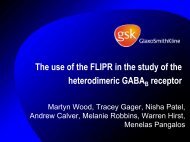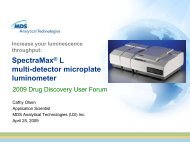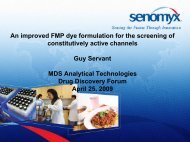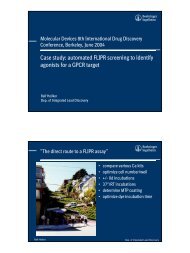Dutch Boltz - Molecular Devices
Dutch Boltz - Molecular Devices
Dutch Boltz - Molecular Devices
You also want an ePaper? Increase the reach of your titles
YUMPU automatically turns print PDFs into web optimized ePapers that Google loves.
<strong>Dutch</strong> <strong>Boltz</strong><br />
• <strong>Dutch</strong> has been at Merck 25 +years. He Has developed<br />
the Cell Analysis Facility at Rahway into a company<br />
wide resource for fluorescence cell based applications.<br />
He got his first FLIPR in 1996. Also, the same year, his<br />
laboratory began a long time collaboration with<br />
Cellomics developing ArrayScan and the nuclear<br />
translocation assay as well Cellomics Store. Today, he<br />
will present “A A Simple Dual-Laser Configuration for<br />
Screening Ion Channels on FLIPR Using Ratiometric<br />
Coumarin-DiSBAC<br />
2 FRET Voltage Sensor Probes”<br />
6/14/2004 Cardiovascular Diseases 1
A Simple Dual-Laser Configuration for<br />
Screening Ion Channels on FLIPR Using<br />
Ratiometric Coumarin-DiSBAC<br />
2 FRET Voltage<br />
Sensor Probes<br />
Richard F.Wnek, Randal M. Bugianesi, Paula M. Dulski, Anna Sirotina<br />
ina-<br />
Meisher, Joe Jackson, <strong>Dutch</strong> <strong>Boltz</strong><br />
Departments of CardioVascular Diseases and Ion Channels, Merck Research R<br />
Laboratories & Product Development, <strong>Molecular</strong> <strong>Devices</strong><br />
6/14/2004 Cardiovascular Diseases 2
Today’s s Presentation<br />
• Review of FRET Membrane Potential Dyes<br />
• Why FRET on FLIPR?<br />
• Design of 2 Ion Plate Readers<br />
• Differences and Reasons<br />
• FLIPR FRET Modification<br />
• Proof of Concept<br />
• Data Comparison 150 Compounds Medicinal Chemistry<br />
• Possible Improvements<br />
• Conclusions<br />
• Rich Wnek’s Poster<br />
6/14/2004 Cardiovascular Diseases 3
Why a FRET Membrane Potential Dye?<br />
• Provides a Ratiometric Measurement<br />
• Cell Number Insensitive<br />
• Temperature insensitive<br />
• Instantaneous Membrane Potential Sensitivity<br />
Measurement<br />
• Increased Signal to Noise – Donor/FRET Only<br />
• Time Domain of Single Channels<br />
6/14/2004 Cardiovascular Diseases 4
Voltage Dependent FRET Mechanism<br />
of Voltage Sensor Probes<br />
+ + + - - -<br />
V m<br />
+ + +<br />
- - -<br />
-70mV<br />
+50mV<br />
+ + +<br />
Extracellular<br />
FRET<br />
V m<br />
---<br />
Extracellular<br />
Intracellular<br />
---<br />
Donor CC2-<br />
DMPE<br />
Acceptor<br />
DiSBAC 2<br />
Intracellular<br />
+ + +<br />
6/14/2004 Cardiovascular Diseases 5
Why Combine FLIPR and FRET Dye?<br />
• Utilize Optimal Parts of Two Approaches<br />
• Increased Sensitivity? on FLIPR<br />
• Increased Reliability?<br />
• Increased Reproducibility ?<br />
• Greater Throughput for Longer Time Courses<br />
> 1-21<br />
2 minutes<br />
• Standardization between Screening Platforms<br />
• Increase Throughput- Multiple Instrument Campaign<br />
6/14/2004 Cardiovascular Diseases 6
Comparison of the Two “I” Plate Readers<br />
“IPR”s<br />
Micro titer<br />
Well<br />
PMT<br />
PMT<br />
2 FL<br />
Slider<br />
Micro titer<br />
Well<br />
Cooled<br />
CCD<br />
6/14/2004 Cardiovascular Diseases 7
IPR Design Criteria<br />
FLIPR<br />
• Ion Channel Screening<br />
• Membrane Potential Dye<br />
• High Throughput<br />
• Kinetic Measurement<br />
• Simultaneous<br />
• Whole Plate<br />
• Temperature Control<br />
• Biology<br />
• Fluorescent Signal<br />
• 488 nm Excitation<br />
“FR-IPR”<br />
• Ion Channel Screening<br />
• More Sensitive S/N<br />
• PMT<br />
• More Rapid Kinetics<br />
• < 20 msec<br />
• Partial Plate PMT<br />
• “Membrane/Potential”<br />
FRET Pair<br />
• Multi Wavelength<br />
(409nm)<br />
6/14/2004 Cardiovascular Diseases 8
Bleed Down of “FR IPR” Membrane<br />
Potential Signal Over Time<br />
16 Well Addition/Detection Array<br />
Negative Controls<br />
Well Acquisition Time<br />
Order<br />
6/14/2004 Cardiovascular Diseases 9
Dual Laser Optical Modification of FLIPR 384<br />
6/14/2004 Cardiovascular Diseases 10
Components Used To Modify FLIPR to<br />
Utilize the Membrane Potential FRET Dyes<br />
• Coherent Innova 302C Laser<br />
• Vintage Newport Research Optical<br />
Positioning Components<br />
• CVI Laser Corp Special Order Optics<br />
• Tunable Laser Mirror 400 nm center 45deg<br />
polarization preserving TLM1-400<br />
400-45p-2025<br />
2.000 x 0.25” 100nm<br />
• Laser Window Plain Window Fused Silica W1-<br />
PW- UV-409<br />
409-488-4545<br />
• Long Wave Pass Dichroic Beam splitter LWP-<br />
45-R400<br />
R400-T480-PW-2025<br />
<strong>Dutch</strong> 2025-UV & Beam Steering Components<br />
• 460/40<br />
Circa 1980<br />
• 565/50<br />
6/14/2004 Cardiovascular Diseases 11
Comparison of Ratio metric Data Acquisition<br />
on the Two “IPR”s<br />
Micro titer<br />
Well<br />
PMT<br />
PMT<br />
2 FL<br />
Slider<br />
Micro titer<br />
Well<br />
Cooled<br />
CCD<br />
6/14/2004 Cardiovascular Diseases 12
FRET Dye Protocol<br />
• 30,000 HEK-2 cells/well<br />
• Incubate overnight.<br />
• Stain Plates with 50µL of 10µM DiSBAC2<br />
• Wash once with 50µL of PBS,<br />
• Stain with 30µL of 5µM CC2-DMPE<br />
• 50µL saline wash.<br />
• Initiate by a 25µL of 30µM Deltamethrin/100nM Brevatoxin<br />
(PbTX-3).<br />
• Experiment is performed at 25°C on both Instruments<br />
• Data Exported to Excel<br />
• Ratio Calculated & Displayed with Original Data in Excel<br />
6/14/2004 Cardiovascular Diseases 13
FLIPR Eliminates Bleed Down of FRET Signal<br />
6/14/2004 Cardiovascular Diseases 14
384 Well FLIPR Ratio Traces for a 16<br />
Point Titration of Four Compounds<br />
Compound<br />
A<br />
Compound<br />
C<br />
Compound<br />
B<br />
Compound<br />
D<br />
6/14/2004 Cardiovascular Diseases 15
Inhibition of Membrane Depolarization by<br />
Compounds A and B<br />
Compound A<br />
IC 50 = 0.074µM<br />
IC 50 = 0.066µM<br />
Compound B<br />
IC 50 = 0.35µM<br />
IC 50 = 0.74µM<br />
FLIPR<br />
FR IPR<br />
6/14/2004 Cardiovascular Diseases 16
Inhibition of Membrane Depolarization by<br />
Compounds C and D<br />
Compound C<br />
IC 50 = 0.13µM<br />
IC 50 = 0.31µM<br />
Compound D<br />
IC 50 = 0.17µM<br />
IC 50 = 0.45µM<br />
FLIPR<br />
FR IPR<br />
6/14/2004 Cardiovascular Diseases 17
Correlation of 150 Medicinal Chemistry<br />
Compounds at 1µM 1 M or 3µM on the<br />
Modified FLIPR and “FR IPR”<br />
6/14/2004 Cardiovascular Diseases 18
Areas for Improvement<br />
• Can Optics Be Better?<br />
• Not a True simultaneous Ratio<br />
• Faster Integration Times<br />
• Faster Filter Changing<br />
• Redisplay of The Two Color Individual<br />
Traces<br />
• Ratio metric Calculation and Display<br />
6/14/2004 Cardiovascular Diseases 19
Conclusion of 488 nm/409 nm FLIPR FRET<br />
Membrane Potential Application Study<br />
• An Additional Laser Beam Can be Combined into The FLIPR 384 Optics<br />
• Original Operation “Unaffected”<br />
• Coumarin DiSBAC2 FRET Data Can Be Collected<br />
• FLIPR Eliminates Signal Bleed Down<br />
• Excellent Titration Data Correlation Between Plate Readers Tested<br />
• IC 50s Consistently Lower<br />
• The System is Robust and Yields Reproducible Data<br />
• Kinetics Appeared to be Faster Than <strong>Molecular</strong> <strong>Devices</strong> Red Dye > 2<br />
Minutes<br />
6/14/2004 Cardiovascular Diseases 20
For More Details and Insight See<br />
Rich Wnek’s Poster<br />
6/14/2004 Cardiovascular Diseases 21
IPR”s s and Their Niche<br />
FLIPR<br />
• > 5-105<br />
sec Time course<br />
• Plate Read = 1 Time<br />
course<br />
• 5 Sec = 5 sec<br />
• 1 minute plate exchange<br />
• Calcium<br />
• Temperature Control<br />
“FRIPR”<br />
• < 1-51<br />
5 sec Time course<br />
• Heterogeneity?<br />
• Plate Read > 12 – 24x<br />
Time course<br />
• 5 sec = > 60 – 120 sec<br />
• Calcium<br />
• No Temperature Control<br />
6/14/2004 Cardiovascular Diseases 22
Abstract<br />
Ion channels are an attractive class of drug targets because of their involvement in a diverse range of<br />
cardiovascular, inflammatory, and neurological disorders. Their pharmacological complexity proves<br />
advantageous for developing highly selective drugs that affect only specific functional states of the channel.<br />
Advancements in fluorescent dyes and optical detection technologies have provided drug discovery programs<br />
with functional screening assays capable of detecting ion channel modulation in an HTS format. We have<br />
developed a membrane potential kinetics screen for a FLIPR-384 instrument that utilizes a FRET-based<br />
coumarin-DiSBAC 2<br />
dye system to screen inhibitors of ion channel X expressed in HEK293 cells. We have<br />
modified a FLIPR-384 instrument with a 409nm krypton laser, introducing the beam co-linear to the 488nm<br />
argon laser path by additional beam steering optics in order to overcome limitations which previously<br />
restricted the use of such FRET based dyes on FLIPR . A number of channel X specific compounds were<br />
screened on the modified FLIPR-384 and compared to results generated on the standard kinetic plate reader.<br />
There was good correlation between both systems for all tested compounds. The modified FLIPR had a<br />
slightly increased sensitivity and a 12-24 factor increase in throughput. Running this assay in ratiometric<br />
mode on FLIPR, reading all 384 wells simultaneously, eliminates the run-down of signal and variability<br />
observed on the other plate reader. These findings demonstrate the feasibility of using a modified FLIPR-384<br />
as an HTS platform utilizing FRET based voltage sensors to identify novel ion channel modulators.<br />
Additionally, the same configuration with an argon-krypton laser substitution for the argon primary laser<br />
would permit the use of virtually any dye on FLIPR with the possibility of simultaneously following two<br />
distinct physiological sensors .<br />
Introduction<br />
Historically, ion channel HTS assays have taken the form of membrane potential or calcium flux population<br />
kinetics. More recent approaches have shifted toward the use of membrane potential sensitive fluorophores<br />
that undergo redistribution within the plasma membrane in response to voltage changes. One such approach<br />
makes use of DiSBAC 4<br />
, or a similar single excitation, single emission dye to measure time courses greater than<br />
10 seconds. A more rapid technique was later developed that utilizes a Coumarin-DiSBAC 2<br />
FRET dye pair to<br />
deal with time courses less than 10 seconds. It has the distinct advantage of functioning as a ratiometric dye<br />
with increased temporal resolution, reproducibility and throughput; advancing measurements beyond the<br />
detection of steady-state changes in membrane potential and avoiding the need for pharmacological<br />
6/14/2004 Cardiovascular Diseases 23<br />
modification of rapidly inactivated or desensitized ion channels.
A Dual-Laser Configuration on a FLIPR 384Instrument<br />
In order to utilize the FRET based voltage sensor probes for ion channel screening on FLIPR a<br />
409nm krypton laser was introduced onto the instrument. At left, the krypton-argon laser<br />
substitution diagram for the primary argon laser. The 409nm beam was introduced co-linear to<br />
the 488nm argon laser path by the addition of beam steering optics. Two dichroic filters are<br />
required to pass the krypton light beam through a mirror and into the FLIPR optical detection<br />
path. The argon light beam passes through the dichroic filter and mirror into the FLIPR optical<br />
detection path. At right, a photograph of the 409nm krypton laser beam path through the beam<br />
steering optics and into the FLIPR. The substitution of the primary light source in conjunction<br />
with the use of multiple filter sets allows one to use a wide range of distinct fluorescent probes.<br />
6/14/2004 Cardiovascular Diseases 24
Coumarin-Donor<br />
Oxonol-Acceptor<br />
Fluorescent Dye Components of the FRET Membrane Potential Assay<br />
A two dye configuration is used in the FRET based membrane potential assay. At left, the<br />
coumarin labeled phospholipid CC2-DMPE molecule which partitions itself into the outer<br />
leaflet of the plasma membrane and serves as the FRET donor. Negative charges from the<br />
coumarin and phosphate groups prevent the CC2-DMPE donor molecule from crossing the<br />
phospholipid bilayer. At right, the negatively charged bis-(1,3-dialkylthiobarbituric acid)<br />
trimethane oxonol acceptor molecule whose position within the bilayer is determined by the<br />
membrane potential of the cell. Both components are very bright fluorophores with a large<br />
spectral separation between emissions making signal separation and detection feasible.<br />
Coumarin excitation is at 410nm and emission at 460nm as compared to Oxonol with an<br />
excitation at 540nm and emission at 570nm.<br />
6/14/2004 Cardiovascular Diseases 25
Conclusions<br />
The addition of a 409nm krypton laser onto a FLIPR-384 instrument has provided our<br />
laboratory with the means to utilize FRET based voltage sensor probe technologies as a<br />
screening tool for identifying ion channel modulators in an HTS format. As an initial study<br />
we developed a membrane potential kinetics screen for the modified FLIPR that utilizes a<br />
FRET-based coumarin-DiSBAC 2 dye system to screen inhibitors of ion channel X expressed<br />
in HEK293 cells. Results from the study indicate that the percent inhibition of<br />
depolarization for channel X compounds generated from data collected on the modified<br />
FLIPR-384 instrument correlates well with that obtained from the standard kinetic plate<br />
reader. The modified FLIPR, in addition, had comparable sensitivity and a 12-24 factor<br />
increase in throughput. The ability to run the instrument in ratiometric mode in conjunction<br />
to imaging all 384 wells simultaneously eliminates concerns such as variability and run down<br />
of signal over time which was observed on the other plate reader during channel X<br />
screening. These findings demonstrate the effectiveness of the modified FLIPR as an<br />
alternative HTS platform for FRET based ion channel screening. In addition, we could use<br />
virtually any dye on the modified FLIPR with the possibility of simultaneously following two<br />
distinct physiological sensors.<br />
References<br />
Gonzalez, J.E. and Maher M.P. Receptor and Channels, 8: 283-295 (2002).<br />
Mattheakis L., Savchenko, A. Current Opinions in Drug Discovery and Development, 4(1): 124-134 (2001).<br />
Gonzalez, J.E., Oades K., Leychkis, Y., Harootunian, A., Negulescu, P.A. Drug Discovery Today, 4(9):<br />
431-439 (1999).<br />
6/14/2004 Cardiovascular Diseases 26
















